So last week Monday morning came around and Professor Thompson had been too busy to prepare gold nano-particles for me. This was fine, I was ready to tackle the task on my own. The procedure involves bringing 100mL of a solution up to a boil and then pouring 3mL of another solution into it. The solution then proceeds to change colors several times, its actually pretty neat to watch. I ended up making a pretty concentrated batch of nano-particles. It even ended looking pretty good under the UV-Vis, so I decided to continue on with my project using them. I needed to find a good ratio of NPs and PAH because the two are pretty fragile. If not mixed together properly they can immediately aggregate and make the solution unusable. Also, if they are not in the proper ratio this can also cause it to become aggregated and then unusable. So I tried to make a 3x and a 5x diluted NPs solution with normal concentrations of PAH. Both seemed usable after mixing. I then tried out the new cleaning procedure that Professor Thompson had suggested. I would spin the solutions at very high speeds, 9000 rxg and 7000 rxg in order to get all of the excess PAH out of the solution. This maximized our risk of contamination by stray PAH particles. My problem with this procedure arose when I had to wash the pellets with DNA in them. After I started this centrifugal process, I found that the solutions were creating pellets that were virtually non-existent. This is not good, as it is one of our main goals to get good pellets here. I was thinking that these pellets could not form because I had diluted the initial amount of NPs in the beginning. Professor Thompson suggested it had something to do with my spinning procedure for the DNA washes. I’m now currently trying this new procedure, which includes longer times and a larger rxg, to get better pellets in my solutions.
Author: Prof. Andresen
Continuation of Week 6
Is finally Friday! Well that doesn’t matter, what matter is what I have accomplish this week. In terms of work, I have accomplish a great deal but in terms of progress I could had accomplish more. I say this because we got our results from Monday and we didn’t get the results we wanted… again. This is really frustrating but like I said last time, researching is about learning from our mistakes and improving upon them even if it takes multiple failures. Once we saw our results, professor Andresen and I came out with a new method to try out it order to see if we were doing our trial digestion correctly. Instead of using our chromatin, we instead used sonicated DNA with our trial digestion to see if we get different results in our gel. In order to do this we must first shred DNA and we would be left with a solution of liquid DNA.Then I added 50 micro-liters of sonicated DNA into two micro-centrifuge test tubes. Once this was done, I diluted the micrococcal nuclease to 100x dilution and also diluted CaC12 in order to add to our two samples. I added 0.5 micro-liters of micrococcal nuclease to one sample and to the other sample I added 2.5 in order to have two different lengths of DNA. Once this was done, I put both solutions in the heater for 15 minutes at 37 degrees Celsius and when this was done I did the same procedure as the previous trial digestions. In the end had two different samples to test in our gel, but I also made some extra samples such as DNA ladder and just the shredded DNA and the same samples with just added DI water. I added this solutions into our gel, and when the results were ready, we again got the results which was more frustrated because it still didn’t work. The results can be seen in the next picture. Figure #1
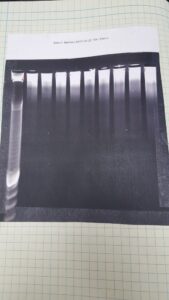 |
| Figure #1: Results from Gel |
From this picture, we can clearly see that we can’t see any base pairs from our samples, only from our DNA ladder which is located to the left. This is the problem that we have been getting on our past trials and from this picture, we think that all of our samples are staying in the beginning of gel. In other words our micrococcal nuclease is not separating our chromosomes.
After this process was done, professor andresen and I decided to do one more trial with the past solutions but this time, instead of making 3% agarose gel, we will be making 1% gel. What this would do, it would make us see the base pairs stuck at the top of gel from the previous samples. For this new trial, I will use two samples with out the proteinase K trial digestion and two other samples with the full trial digestion. Unfortunately when I was moving the agarose gel to the special the machine that was gonna give me my results, the gel felt apart and what this meant was that I needed to redo my work all over again. which I eventually did.
The next day I ran the gel and while I was waiting for the gel to be done I prepared another trial digestion that I will do next week. This new trial digestion consisted of time intervals of 5, 10, 20, 40, and 60 minutes and 1.6 micro-liters of 100x diluted micrococcal nuclease.
Once the gel was done, I look at the results and they were a little better than previous results but it still didn’t show the base pairs that we want it to see. We are hoping that next week with this new trial digestion, we will be able to see the results we want to see. Its a struggle keep seeing how our trials always fail but even though its slowly, we are making progress and we will be able to find what is causing our results.
End week six
The last run of samples was supposed to be our most promising samples yet. It had looked like we were going to get not only quality data but in a large quantity as well. Unfortunately, something had gone awry. When we start with out citrate nano-particles they should be negative in charge, then we wrap them in PAH and they switch to positive charge, and then finally we wrap them in DNA and they switch charges a final time, back to negative. My first two Zeta tests were conclusive and yielded the expected results, however the final one simply doubled the number and did not switch the charge at all. Professor Andresen phoned a friend and we then scheduled a conference with Professor Thompson. Before we could have this conference however, I first had to prepare a power point presentation on my most recent bit of research. Dr. Thompson broke down several of the data pieces I am so accustomed to collecting and helped me better understand them. The UV-Vis is a lot more helpful then I know it to be, but I really need to learn how to overlay graphs on it, I am determined to learn this early next week when I have to use the machine again. The conference left me feeling very hopeful about the project. On Monday Professor Thompson is going to prepare more nanoparticles for me to use in my next batch of samples. He also suggested a much more appropriate way of preparing the PAH wrap and how to more properly purify them. I am hopeful that this will greatly improve the project. At the end of this week, I am wrapping it up by shearing DNA and looking forward to finally getting proper data next week.
Week six
So at my last post I had just found an appropriate mix of salts and nano-particles. This allowed me to then mix in my DNA and start performing equilibrium dialysis. However, I immediately ran into another big problem. What was I to re hydrate my solutions with? In the past, at this step I was not using citrate nanoparticles, but I was re hydrating with TEM buffer. I was uncertain if this would be efficient with these new particles. I decided to head to the science center and discus this problem with Rich, a fellow user of similar nano-particles. We threw a few ideas back in forth, but nothing seemed like an exceptionally good idea to re hydrate with. So I had to make a sacrifice, I gave up any hope of getting to use the ICP-OES this run in order to figure out what to re hydrate my samples with. I split my total solution of nano particles into three parts, one would be re hydrated with mili-Q, another with TEM buffer, and a third with a solution that was 10^-2 M NaCl. Unfortunately I was only re hydrating with 4mL each when I typically do double that. Regardless, the results appeared to be conclusive, showing that the salt buffer worked the best.
So then I had to restart once again. This time, I took all of my gold nano particles and coated them with PAH. I then spun them in the centrifuge for an increasingly long period of time to siphon out the supernatant and continue spinning that. Finally, I recombined the pellets and diluted it back to 7mL with more nano particles. So I’m left with 1 super concentrated gold nano particle sample and 7 other slightly less concentrated samples. They were then all mixed with DNA and left to sit over night. Now I am currently trying to perform equilibrium dialysis, and hopefully after doing this I’ll finally be able to use the ICP-OES.
End of fifth week already?
We decided that we would keep the relative concentrations of DNA and Cobalt Hexammine unaltered in the different ITC runs. The concentrations of DNA and Cobalt Hexammine used in the experiments were 2.5mM DNA+3mM Cobalt Hexammine, 5mM DNA+6mM Cobalt Hexammine, 10mM DNA+12mM Cobalt Hexammine. In addition, we decided to alter the experimental procedure a tad bit. We decided to form isotonic DNA+NaCl solutions using the dialysis method so that the concentrations of NaCl in all the samples are equal. The dialysis buffer was used for the serial dilution of the 120mM stock Cobalt Hexammine (instead of water as in the previous experiments).
After I prepared the batch of DNA samples (of different concentrations) using the regular method, I filled up dialysis tubes with 10ml of each sample. I left the tubes in a dialysis buffer of 10mM NaCl solution overnight. I used the same dialysis buffer for the serial dilution of the 120mM stock of Cobalt Hexammine in order to synthesize 10ml of 12mM,6mM and 3mM solutions respectively.
After the synthesis of the DNA samples and the Cobalt Hexammine solutions, I ran heat of dilution tests on the Cobalt Hexammine samples. Here are the results:
6th week, New trial digestion with some changes.
Wow! it’s the sixth week, seems like time never stops and always keeps moving. Well today is a Monday, which are never a good feeling but we gotta hang in there. I started my day by going over the results with Professor Andresen, in order to come out with a solution or a new procedure. Eventually professor Andresen did came out with a new procedure which is the same procedure has before but with slightly different trial digestion. Instead of creating different samples of our solution by adding different amounts of micrococcal nuclease, we instead only made two 50 micro-liters of solution which contain different amounts of micrococcal nuclease. I places this solutions into the heater for 37 degrees Celsius and took out 5 micro-liters of each solution at a specific time. The different times that we assigned were 5, 20, and 40 minutes, with another sample that lasted about 2 hours. This procedure accomplished the task of creating different sizes of DNA by letting the microccocal nuclease eat up the nucleic acids and taking small amounts of sample at different times and stopping the process by adding EDTA. Once this process was finish, I continued the trial digestion with the same procedure as before by using proteinase K and SDS. In the mean while, I created a new gel in order to put the trials in tomorrow. I also made more TBE buffer to used the next day. All this procedure took approximately the whole day due to the unfortunately broken wrist I got. All is well and I could still work, and that’s really important to me because I never give up on something I start.
Final day of Week #5. Finally able to see Results
Its Friday! It is always good to come to work on a Friday because you feel at easy with yourself and work just for the fact that once this day is over, you can rest for two whole days.
Well I started my day out by making more TBE buffer, which consist of 50 ml of TBE (Tris-Borate-EDTA buffer) and 450 ml of DI water. Once I was done making this buffer I made two DNA ladder, DNA ladder is a solution of DNA molecules of different known lengths and is used to run along side our samples in order to estimate the size of our samples. Once this was done, I prepared an extra micro-centrifuge tube with only 1 micro-liter of our chromatic supernatant, 9 micro-liters of 60% sucrose and 10 micro-liters of DI water. I made this extra sample in order to see how it looks on the gel without the trial digestion. For the solutions who already had already been through the trial digestion, I took 1 micro-liter from each and added them to new micro-centrifuge test tubes with the same numbers label in order to not get mix up. I also added 9 micro-liters of 60% sucrose and 10 micro-liters of DI water to the new test tubes. Once this was done I was ready to add them into my gel. The solutions on the gel can be seen in figure #1.
 |
| Figure #1 Samples added to Gel |
Once I loaded all of my samples into the gel, I set the voltage to 100 volts and waiting until a blue line reached 5 cm. While I was waiting for this process to happen, I started to unpack all of the materials that we ordered in order to have more stock available to used in the future. It was like Christmas morning, unpacking all of the boxes. See figure #2
 |
| Figure # 2 Material needed for present and future usage |
Once the unpacking was done, our shelves finally looked like they had material in it and it looks awesome. See figure #3
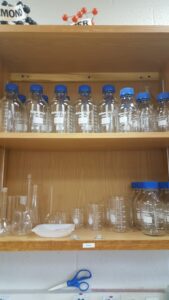 |
| Figure #3 More beakers to make more Buffer |
Week Five
The results from the last experiment I mentioned in my last blog post were inconclusive. Along with the next few experiments that had occurred after that. Now I’m not saying that it is impossible to get the data that we wanted to get with the materials that I was using, however, Professor Andresen pointed out that if the experiment was this finicky then no one would care about it enough to try to reproduce it. So later that day he found me a brand new batch of nano particles. This time we got Citrate coated gold nano particles and this changed our procedure slightly. The general idea now is to take the negatively charged gold nano particles and wrap positively charged PAH around the gold. Then we’ll wrap the DNA around the PAH/Gold complex. I was very excited to get away from the old procedure that I couldn’t figure out how to fix. The first problem we ran into with this new experiment was trying to coat the gold with the PAH. When I followed the old procedure something strange happened.
5th week, final steps on the preparation of Mononucleosomes
When I came back on Wednesday, I took out my solutions from the refrigerator and stop the spinner. This was a struggle but not because it was hard removing the equipment from the refrigerator but for removing it with a wrist paint I felt during this process. This was due to the accident I had with my skate board but as a hard worker I still manage to complete my task and keep working. Once the solution was out of the refrigerator, I put the solution into a special test tube which you are able to see in figure #1 and you are also able to see my wrist support that one of my lovely friend let me borrow.
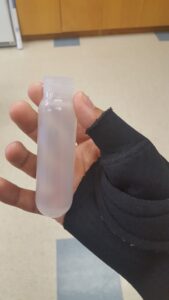 |
| Figure #1 Special test tube for Centrifuge, this is test tube is used when using a powerful Centrifuge that goes faster than 3900xg |
I set the centrifuge to a speed of 5000xg for 5 minutes and after this was done, I removed the supernatant and measured the Concentration of DNA using the UV-vis equipment. From our collected data, professor Andresen and myself found our that we lost about 300 mg of chromatin from our previous UV-vis sample but that is to expected when doing this kind of washing and processes. Once this was done, I dialyses my supernatant against 10mM Tris-HCI and 1mM CaC12 at 4 degrees Celsius. I was only able to create three dialysis bags for my supernatant due to the fact that my supernatant volume was a lot, the rest of the supernatant will be placed in dialysis bags the next day.
The next day I came back, I removed the dialysis bags from the buffer and created the rest of the dialysis bags for the rest of my supernatant. Once this was done I started the process for the Trial Digestion of my mononucleosomes. I prepared six different microcentrifuge tubes and label them with different numbers, shown in figure #2.
 |
| Figure #2 Two rows of different samples and different concentrations of Micrococcal Nuclease |
Figure #2 shows two different rows of solutions, one solution was made up of 50 micro-liters of our supernatant and different concentration of Micrococcal nuclease. Once again Micrococcal nuclease is used to digest nucleic acids. We set this solutions to heat up for 55 minutes at a temperature of 37 degrees Celsius and once this is done we removed them from the heater and add 0.5 micro-liters of EDTA to stop this reaction. When we are done with all of this, we again prepare six other micro-centrifuges tubes with the same numbers but with an extra PK on the side to represent Proteinase K. This new tubes contain five micro-liters of our digested chromatic solution, five micro-liters of proteinase K, and 0.5 micro-liters of SDS. We then set this samples into the heater for 50 minutes at 50 degrees Celsius. Once this is done, we can placed our samples in the refrigerator to be used for the next day. During the time I was waiting for my solutions to heat up, I was making new Agarose gel in order to used it the next day and placed my samples in it.
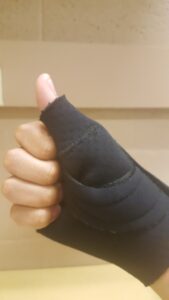 |
| Figure #3 Never give up! even if you feel like your hand is going to fall. |
5th week, Continuation of the preparation of Mononucleosomes
I started this new week by re-suspending my nuclei in 8ml of ML and spind it down at 3000xg for 5 minutes. I did this process 4 times in total and all of this is done for the preparation of Mononucleosomes. Once this was done four times, I removed the supernatant and took a small sample in order to check for how much DNA concentration I had and added 2M of CaC12 to make 1mm. Once this was done I need to make a calculation of how much Micrococcal nuclease to add to each sample. Micrococcal nuclease is used to eat up the DNA strands until it reaches the nucleus. Once I found the correct amount of Micrococcal nuclease to add, I pre-equilibrated the solution to 37 degrees Celsius for short DNA fragments for 30 minutes. Once the timer is up, in order to stop the reaction, I must add 10mm of EDTA, for my specific amount of solution, I added 161.488 micro-liters of EDTA. When all of this process was done, I was once spun the solutions at 1000xg for 5 minutes at 4 degrees Celsius. The final I step I needed to do was to create dialysis bags and let them sit over night, In my case I made 4 different dialysis bags, 3 containing our supernatant and the other containing the nuclei (left over white solution). The next pictures show the tools used to make the dialysis bags.
 |
| Dialysis tubing and Clips. |
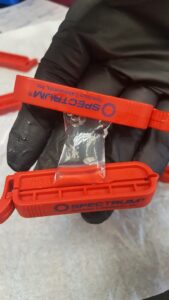 |
| Dialysis bag |
 |
| Dialysis bags, all inside 500mL of EDTA. This must be left over night. |








